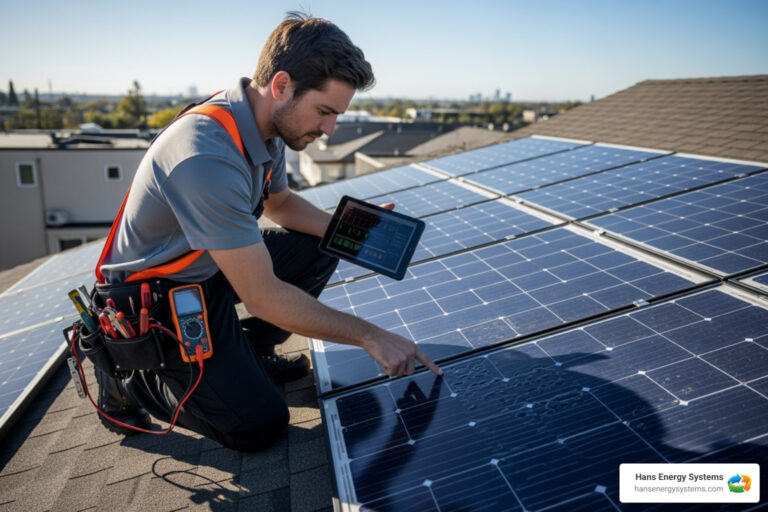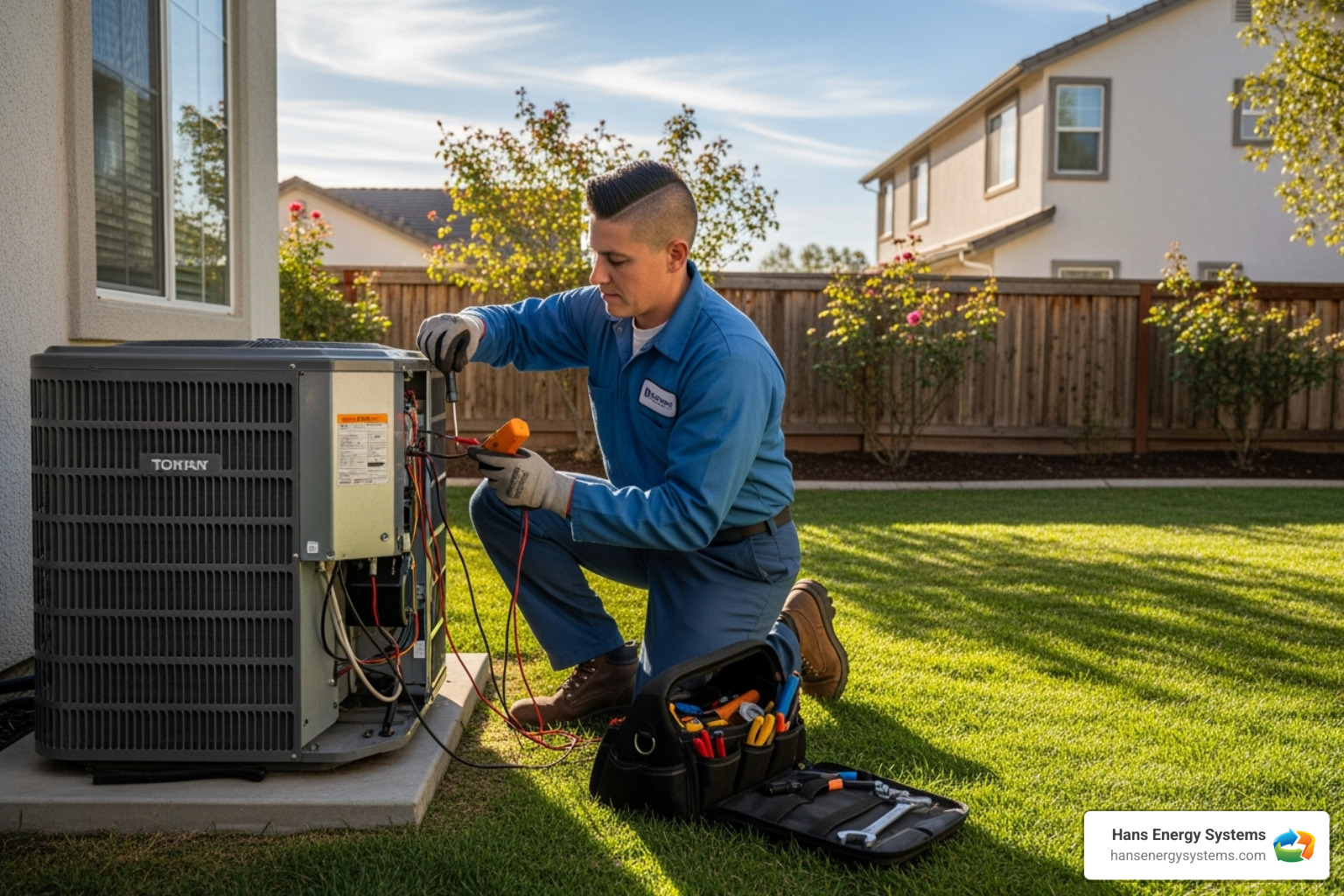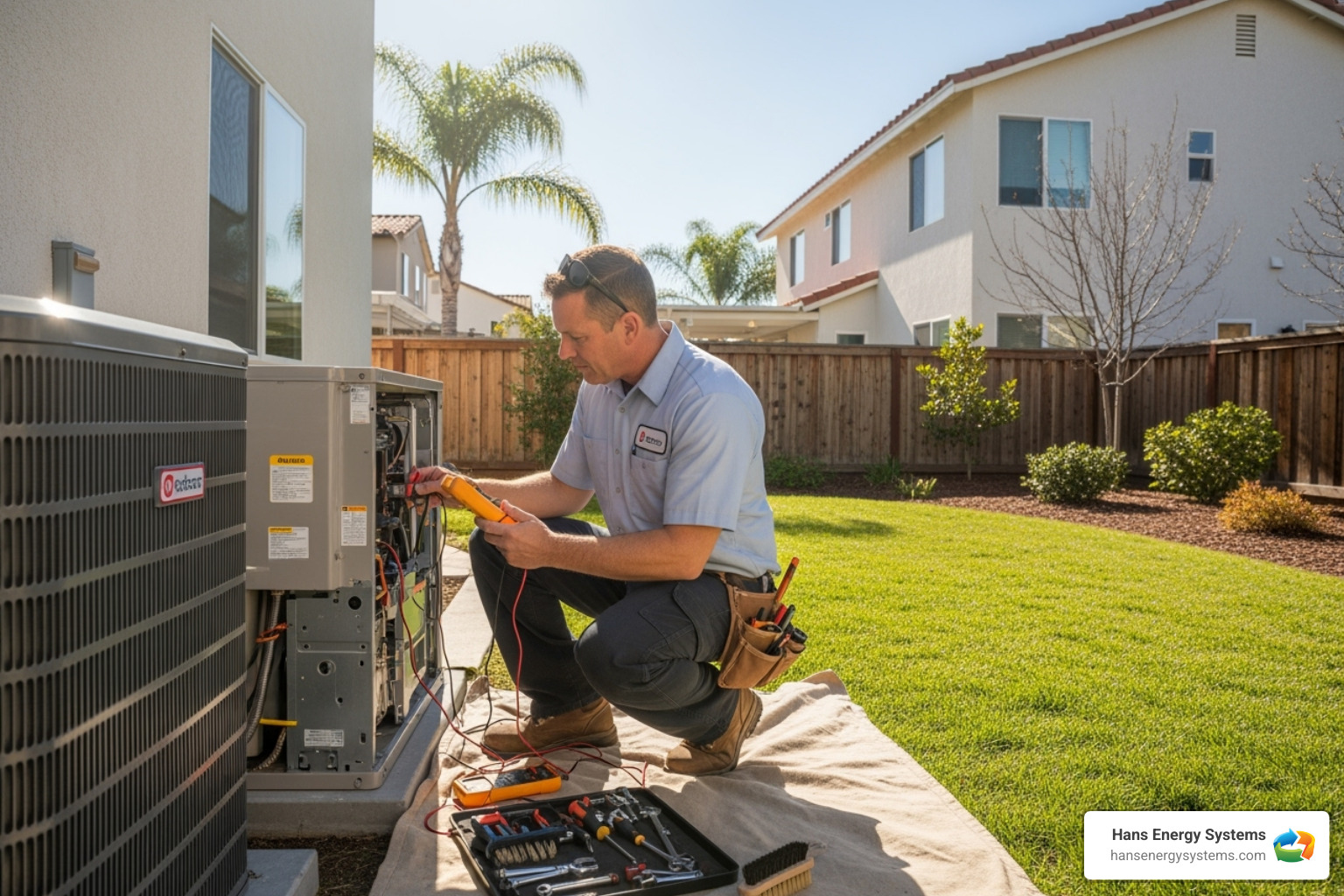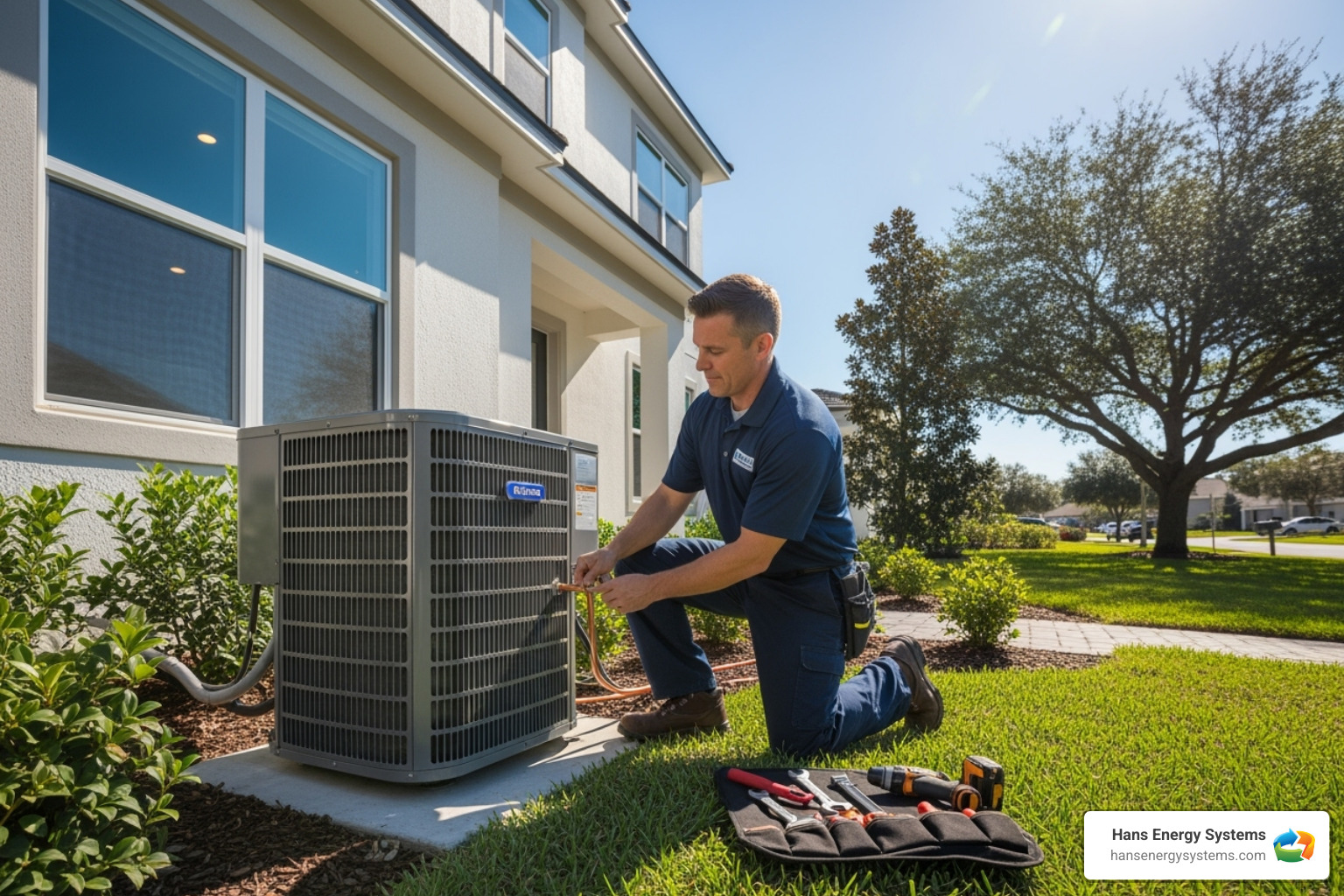Why Solar Panel Repairs Matter for Your Investment
When you need solar energy repair near me, acting quickly protects your investment and keeps your energy savings on track. Solar panels are designed to last 35-40 years with minimal maintenance, but when issues arise, professional diagnosis and repair restore peak performance.
Quick Guide to Solar Energy Repair Near Me:
- Common Issues: Inverter failures, wiring problems, panel damage, monitoring system disconnects
- When to Call a Pro: Performance drops suddenly, inverter goes offline, physical damage visible, error codes appear
- What to Expect: Diagnostic inspection, transparent pricing, warranty-backed repairs
- Average Response Time: Most local contractors respond within 24-48 hours
- Typical Repairs: Inverter replacement, wiring fixes, panel cleaning, monitoring reconnection
Most solar system problems aren’t with the panels themselves – they’re incredibly durable. According to industry data, solar panels degrade by only 0.6-0.8% per year after the first year of operation. The real culprits are usually inverters, wiring connections, or monitoring systems that have gone offline.
One solar repair customer shared: “I called after my solar panels were installed by a company that went out of business. The new repair team quickly diagnosed the problem and had everything running smoothly again.” This highlights why finding a reliable local repair service matters – your original installer might not always be available.
The key is recognizing the warning signs early. Your monitoring app might show reduced efficiency, your electricity bills could spike unexpectedly, or you might notice physical damage after a storm. Professional solar repair technicians have specialized tools like 5kva meggers to track down electrical faults and the expertise to work safely with high-voltage DC systems.

Is Your Solar System Underperforming? Common Signs You Need a Repair
While solar panels are durable, your system is a complex network. Knowing the signs of trouble helps you pinpoint issues early, ensuring your system continues to harness the sun’s power efficiently. From subtle dips in production to system shutdowns, we can help you understand what might be happening.
Telltale Signs from Your Monitoring App and Bills
One of the greatest advancements in solar technology is the ability to monitor your system’s performance right from your smartphone or computer. Your monitoring app is usually the first place to check for clues.
- Sudden Performance Drop: This is often the most obvious sign. Your monitoring app displays your daily or hourly energy production. If you see a significant, unexplained drop in performance compared to previous days, especially on a sunny day, it’s a red flag. For instance, if your panels consistently produced 20 kWh per day and suddenly drop to 10 kWh, something’s amiss. A sudden, sharp decline goes far beyond the normal, gradual degradation of about 0.6-0.8% per year.
- Inverter Offline Alerts: Your inverter is the brain of your solar system, converting DC electricity from your panels into the AC electricity your home uses. If your monitoring app shows your inverter is offline, or if you see an error message on the inverter itself, your system isn’t producing any power. This common issue requires professional attention. Signs of a failing inverter can include unusual noises, a flickering display, or frequent shutdowns.
- Error Codes: Many inverters and monitoring systems display specific error codes when a problem is detected. These codes can help us diagnose the issue quickly. While some minor errors might clear themselves, persistent codes indicate a need for a professional inspection.
- Higher-than-expected Electricity Bills: This is the ultimate real-world indicator that your solar system isn’t pulling its weight. If your electricity bills start creeping up, it means your panels aren’t offsetting as much of your consumption as they should be. This could be due to a gradual decline in performance or a more significant underlying issue.
When you notice any of these signs, it’s time to consider a professional diagnosis. Our experts are well-versed in handling complex solar panel issues and can quickly get to the root of the problem. You can learn more about How Experts Handle Solar Panel Repair in Poway on our website.
Physical Clues: What to Look for on Your Roof
Sometimes, the problem is visible on your roof. While we don’t recommend climbing onto your roof yourself for safety reasons, a visual inspection from the ground can reveal important clues.
- Cracked Glass: Solar panels are tough, but they can be damaged by severe weather or falling debris. A cracked glass surface compromises a panel’s integrity and performance.
- Discoloration or Hot Spots: Look for dark spots or areas of discoloration on your panels. These “hot spots” indicate that a part of the panel is overheating, which reduces efficiency and can lead to further damage.
- Loose Panels or Racking: Panels should be securely fastened. If you notice any panels that appear loose, shifted, or if the racking itself looks damaged, it’s a structural issue that needs immediate attention, especially during high winds.
- Damaged Wiring: Exposed wires can be damaged by pests or weather. Damaged wiring can lead to performance issues or safety hazards.
- Critter Damage: Pests love to nest under solar panels and can chew through wires or block airflow. Installing critter guards is an excellent preventative measure. If you suspect pests are causing issues, it’s best to call a professional.
Weather plays a significant role in the need for repair. Extreme temperatures, high winds, and hail can take a toll. For example, heavy rains can cause significant roof leaks if the original installation didn’t properly seal the mounting points. It’s crucial to Protect Solar Panels from Storm Damage through proper installation and timely repairs.
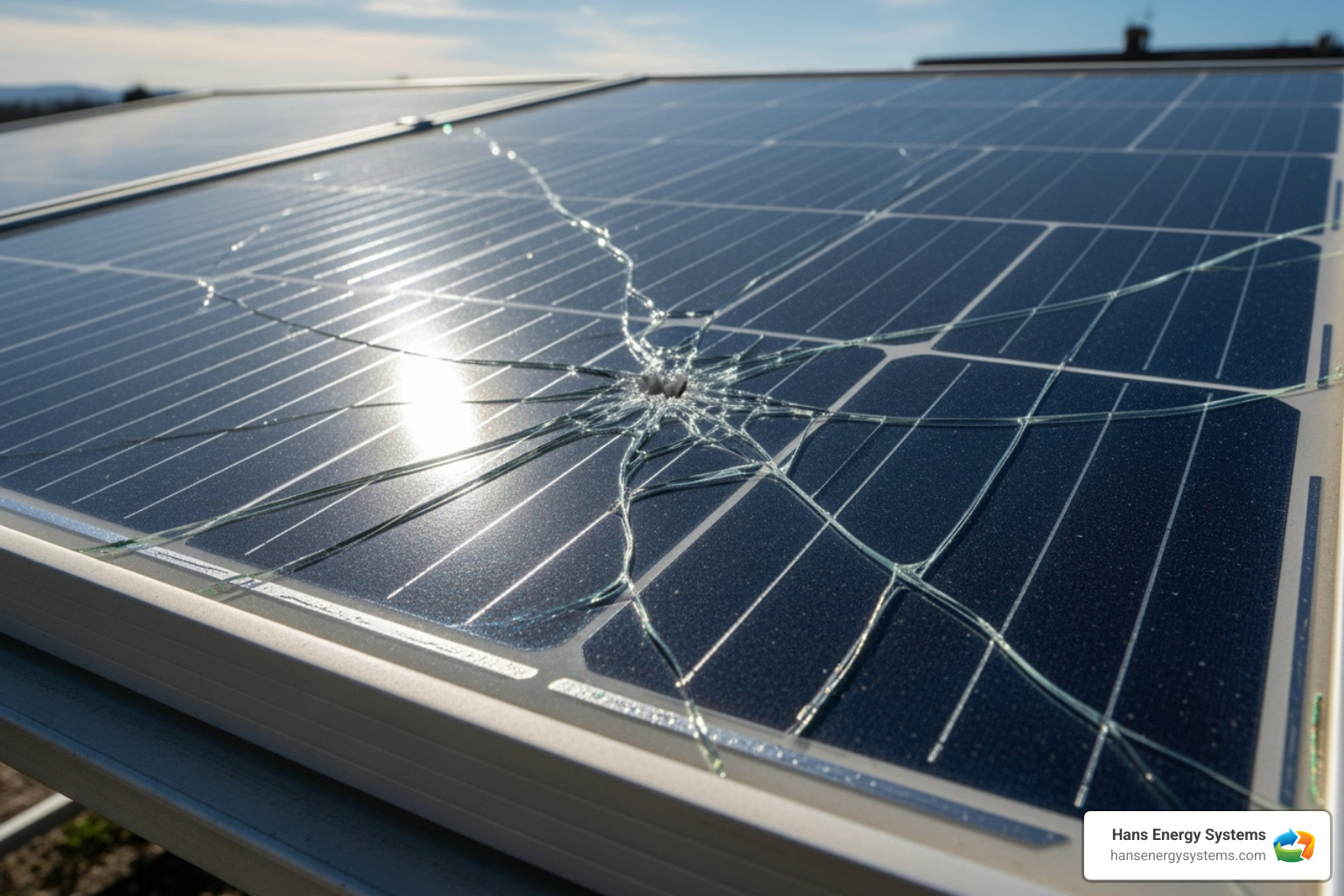
Repair or Replace? Understanding Solar Panel Lifespan
When facing a solar system issue, the big question is whether to repair or replace. Understanding the lifespan of your components is key.
Solar panels are designed to last 35-40 years. Most manufacturers offer a 25-year power output warranty, guaranteeing panels will produce at least 80% of their labeled power by the end of that period.
So, when does repair make sense versus replacement?
- Minor Component Issues: If the problem is with an inverter, a single panel, or wiring, repair is usually the most cost-effective solution. Inverter failures are the most common component to need repair or replacement.
- Warranty Coverage: Always check if your components are still under warranty. Most panels have a 25-year power warranty and a 10-12 year product warranty. If the issue is covered, the cost to you could be minimal.
- Performance vs. Age: If your system is relatively new (under 15 years) and has a significant performance drop, repair is almost always the answer.
- When Replacement is the Better Option: If your system is very old (over 25 years) and multiple components are failing, replacement might be more economical. Newer panels offer higher efficiency and a greater return on investment.
For commercial solar energy systems, maximizing lifespan is crucial. You can explore more about how to Maximize Lifespan of Commercial Solar Energy on our site. A professional assessment can provide a clear cost-benefit analysis to help you decide.
DIY Fixes vs. Calling a Pro: A Guide to Solar Panel Maintenance
When searching for solar energy repair near me, it’s natural to wonder what you can handle yourself versus what needs a pro. Solar panels are low-maintenance, but there’s an important line between smart upkeep and dangerous DIY attempts. Solar systems involve high-voltage electricity, so knowing when to step back is crucial for your safety.
Safe DIY Solar Maintenance You Can Do
The beauty of solar panels lies in their simplicity. Most maintenance involves keeping them clean and monitoring their performance.
Cleaning panels from dirt and debris is one of the most valuable things you can do. Dust, pollen, and bird droppings can block sunlight and reduce efficiency. While rain helps, a gentle rinse with a garden hose can work wonders. For stubborn spots, use a soft brush with purified water to avoid mineral deposits.
Pro tip: clean your panels on a cool, cloudy day or early in the morning to avoid thermal shock from cold water on hot glass. If you have ground-mounted panels, cleaning is straightforward. For rooftop systems, only clean what you can safely reach from the ground.
Checking your monitoring software regularly puts you in control of your system’s health. Look for performance drops, error messages, or inverter alerts. The sooner you spot problems, the faster they can be fixed.
Visual inspections from the ground can reveal obvious issues without risk. Look for cracked glass, loose wiring, or new shade from growing trees.
Safety always comes first. Never climb on your roof without proper equipment and training. Avoid working with water near electrical components, and never attempt maintenance during storms or when panels are wet. When in doubt, call us.
For detailed cleaning techniques, check out our guide on Solar Panel Cleaning and Maintenance.

When to Leave It to the Professionals
Anything involving electrical work is off-limits for DIY. Solar systems operate with high-voltage DC electricity that can be fatal. Working with wiring, connections, or inverters requires specialized training and tools that homeowners don’t have.
Roof-based repairs are another professional-only zone. Solar work involves specific safety protocols, insurance, and technical knowledge about mounting systems. One wrong move can damage your roof or cause serious injury.
Inverter troubleshooting is complex. What looks like a simple reset might indicate a deeper problem that requires professional diagnostics.
Warranty protection is a major consideration. Attempting DIY repairs on equipment still under warranty will likely void that coverage. We know how to handle warranty claims and ensure repairs meet manufacturer specifications.
Annual professional inspections are like a physical for your solar system. Our technicians can spot potential issues before they become expensive problems by checking all electrical components, wiring, and mounting hardware.
Regular electricians are not qualified for solar work. The high-voltage DC electricity and unique safety requirements demand specialized training and certifications, making it a distinct field.
For thorough system assessments that catch problems early, consider scheduling a Professional Solar Panel Inspection in Poway. Your safety and your system’s performance are worth the investment in professional expertise.
How to Find Reputable Solar Energy Repair Near Me
When your solar panels aren’t performing, finding the right professional for solar energy repair near me can feel overwhelming. You need an expert who understands your investment and will treat it with care.
With solar energy’s popularity in San Diego County, finding qualified repair professionals is easier, but not all companies are created equal.
Steps to Find a Qualified Solar Energy Repair Near Me
Finding a solar repair company is like finding a good mechanic: you want an expert who communicates clearly and stands behind their work.
Start with an online search for “solar energy repair near me” or “solar panel repair in your city.” This gives you a starting point for deeper research.
Check reviews on trusted platforms like Google and Yelp. Look for patterns in customer feedback regarding response times, professionalism, and first-time fixes. Note how companies respond to negative reviews.
Ask your neighbors for referrals. Word-of-mouth recommendations from people who’ve used a service are invaluable.
Get multiple quotes from at least two or three companies. This helps you compare costs and see how each company approaches your problem. A good company will ask detailed questions and explain their diagnostic process.
What to Look for in a Solar Repair Company
Once you have a shortlist, it’s time to separate the professionals from the rest. Look for NABCEP certifications—the North American Board of Certified Energy Practitioners. This certification means technicians have met rigorous standards for solar technology.
Verify proper licensing and insurance because solar work involves both electrical systems and rooftop access. This protects you if something goes wrong. In California, solar companies need specific licenses to perform this work legally.
Experience in your local area is crucial. A company that has served San Diego County for years understands local weather patterns, building codes, and common regional issues. At Hans Energy Systems, we’ve built our reputation on understanding what local homeowners need.
Read customer testimonials, not just star ratings. Look for specific examples of how companies handled challenging situations. Transparent pricing is another must-have; reputable companies provide clear, detailed estimates with no surprise charges.
When talking to potential technicians, ask about their experience with your system type, their diagnostic process, and how they handle repairs when the original installer is out of business. Also, inquire about response times and warranties on their repair work.
Understanding Repair Costs and Warranties for Solar Energy Repair Near Me
Understanding repair costs helps you budget. Diagnostic fees are standard, as it takes time and expertise to accurately identify the problem.
Repair costs vary widely depending on the complexity of the problem and the parts involved. A simple monitoring fix is much different from an inverter replacement.
Your warranties are your friend. Solar panels typically have a product warranty (10-12 years) and a performance warranty (25 years). Inverters have their own warranties, often 5 to 12 years.
Check your original installation paperwork for workmanship warranties. If the repair is needed because of faulty installation, this warranty might cover labor costs. Keep all your warranty documents in a safe place.
If your original installer went out of business, a good repair company can still help you steer manufacturer warranties. You may have to pay for labor, but the parts might still be covered.
Frequently Asked Questions about Solar Panel Repair
When you’re searching for “solar energy repair near me”, it’s natural to have questions. We’ve been helping San Diego County homeowners for years, and these are the questions that come up most often.
How often do solar panels need repair?
Solar panels themselves rarely break down. They are built to withstand weather and produce clean energy for 35-40 years with little fuss.
Most of the time when we get a call for solar energy repair near me, the issue isn’t the panels. Instead, we’re usually dealing with inverter hiccups, loose wiring, or monitoring systems that have gone offline. Regular maintenance, like cleaning and monitoring, can prevent most repair calls.
What is the most common solar panel repair?
After years of service calls across San Diego County, we can tell you that inverter problems top our list by a wide margin. Your inverter works hard every day converting DC power to the AC power your home uses, making it the most likely component to need attention.
Most inverters last 10-15 years. When they act up, your monitoring app will likely show the system going offline or display error codes.
Other common culprits include loose wiring, monitoring system connectivity issues, and occasionally a faulty bypass diode within a panel. The good news is that these are straightforward fixes for experienced solar technicians.
Can a regular electrician fix my solar panels?
This is an important question, and our answer is always no. While we respect electricians, solar energy systems are a completely different animal.
Your home runs on AC electricity, but your solar panels produce high-voltage DC power. Working with DC electricity requires specialized training and safety protocols that most general electricians do not have.
Professional solar technicians have specialized training and certifications (like NABCEP) to work safely with these systems. They use diagnostic tools and understand components like inverters and optimizers. Using a general electrician could void your warranty, create safety hazards, or cause more damage. When you need reliable solar energy repair near me, choose technicians who specialize in solar.
Conclusion
Caring for your solar system isn’t overwhelming. We’ve covered the key warning signs that you need solar energy repair near me, from performance drops to physical damage. The most important takeaway is that acting quickly protects your investment and your energy savings.
Most solar issues aren’t with the panels themselves, which are built to last for decades. Problems usually crop up with inverters, wiring, or monitoring systems. The good news is that with timely professional repairs, your system can get back to peak performance quickly.
While basic maintenance is a great DIY task, electrical work must be left to certified professionals. The high-voltage DC electricity in solar systems requires specialized training. Your safety and warranty protection are paramount.
When searching for solar energy repair near me, look for companies with proper certifications like NABCEP, solid local experience, and transparent pricing. Check your warranty documents first—you might find your repair is covered.
At Hans Energy Systems, we’ve been helping San Diego County homeowners protect their solar investments for years. Our team understands that every day your system isn’t running optimally is money out of your pocket. We are equipped to quickly identify issues—whether it’s a failing inverter, storm damage, or critter problems—and get your system back to using the sun’s full power.
Your solar system is a smart investment. With proper care and timely professional repairs, it will deliver clean energy and lower electricity bills for decades.
For homeowners in Poway and throughout San Diego County, we’re here when you need us. Get professional Solar Panel Repair in Poway, CA and let’s get your system running like new again.


